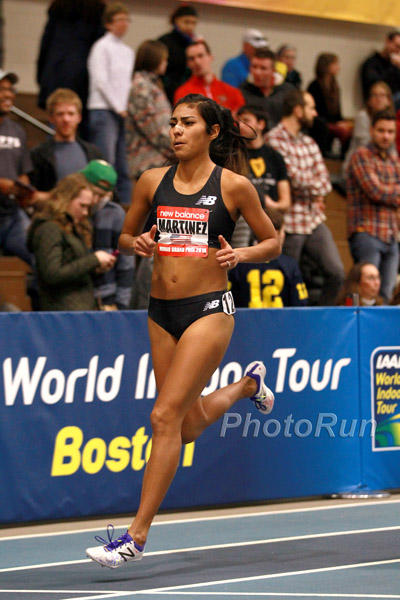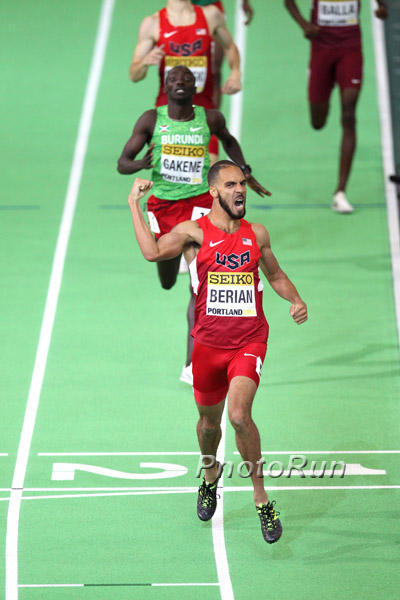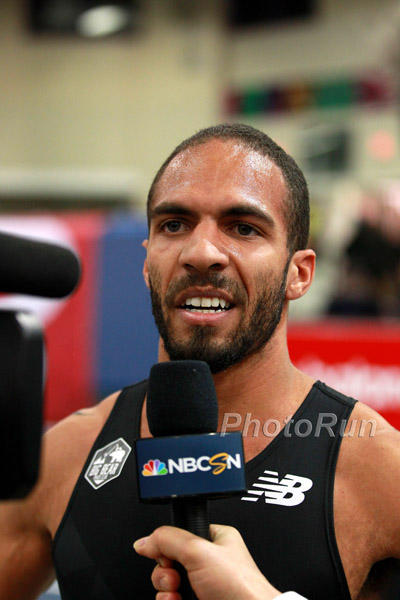 Brenda Martinez, photo by PhotoRun.net
Brenda Martinez, photo by PhotoRun.net
Mark Winitz wrote the following piece on the Big Bear Track Club, one of the new and impressive clubs on the US running scene. Kudos to Brenda Martinez and her husband, Carlos Handler, for putting the time and effort into providing another important opportunity to develop young American athletes.
Giving Back at Big Bear Track Club
By Mark Winitz
U.S. track and field middle distance standout Brenda Martinez was always club oriented. Despite her parents’ instructions not to, even before she entered elementary school, the precocious youngster would run down the streets of Rancho Cucamonga in Southern California to visit her friends. So, when Martinez was five years old her parents put her in a youth track club, the West Coast Gazelles, to keep her off the roads, on track, and safely occupied after school. The Gazelles ran their workouts on the oval at Rancho Cucamonga High School, which Martinez subsequently attended. And, to this day the 2013 IAAF World Championships bronze medalist at 800 meters maintains her passion for running with a club.
“I’ve always loved the positive environment of peer support, and going to practice,” Martinez said about club/team running. “I really look forward to helping people along the way, and feeding off each other. You feel motivated because you inspire other athletes.”
Two years ago, Martinez and her husband, Carlos Handler, founded Big Bear Track Club with an ambitious primary mission in mind: To provide an opportunity for talented middle and long distance runners to train in a team/club environment that will prepare them to compete on a level with the best in the nation and in the world, including Olympic competition. Until relatively recently, the club operated mostly under the radar of the general track and field public.
That started to change when Boris Berian burst on the international scene last summer–barely six months after Berian moved from Colorado to join the Big Bear TC–by finishing a close second to world record 800m record holder David Rudisha in the two lapper at the Adidas Grand Prix meet in New York. The breakout performance was closely followed by Berian’s 1:43:34 at Monaco Diamond League a month later (the fastest U.S. men’s 800m, and the fourth fastest in the world, in 2015). Not long after track pundits started to ask “Where did Boris Berian come from?” and “What’s Big Bear Track Club?” By the time Berian emerged as this year’s U.S. and World Indoor 800m champion a fair portion of the sport’s fan base was asking the same questions.
We caught up with Martinez, Handler, Berian plus highly regarded distance running coach Dr. Joe Vigil–the club’s primary influencer and consultant–to find out more.
Big Bear Track Club is currently composed of 11 athletes (including Martinez and Berian). It is based at Big Bear Lake, a small city and mountain resort community located in the foothills of the San Gabriel Mountains, about 92 miles east of Los Angeles. The club was recently approved as a California non-profit corporation.
Click here to visit the Big Bear TC website and view their current roster of athletes, plus bios.
Why Big Bear Lake? That’s a story in itself. Here it is, in brief:
Martinez graduated from the University of California, Riverside in 2010 where she set numerous school records outdoors and indoors ranging from 800m to 5,000m. She met Handler, her future husband whom she married in 2012, as a collegiate junior. Handler had competed at UC Riverside from 2001-2004 before transferring to Concordia University in Irvine, Calif. At Concordia he finished his remaining eligibility while receiving seven All-Americans awards and leading the men’s cross country team to its highest placing in school history in ’05 and ’06 as runner-up cross country National Champions.
Following college, the couple moved around a bit, first to Boulder and then to Alamosa, Colo., trying to find the right training group and, most importantly, the right coach. Martinez had signed a professional contract with her current sponsor, New Balance, and the couple knew that Martinez had a lot more in her.
“Coming out of college, Carlos (Handler) didn’t want to coach me because he didn’t have any coaching experience at that point,” Martinez explained. “So we kind of went around looking for coaches and an environment where to live.”
In 2011, while in Alamosa, Handler contacted celebrated distance coach, Dr. Joe Vigil, for advice. Handler first met Vigil when he was a student at Vista Murrieta High School in Murrieta, Calif.–where Vigil occasionally stopped to give talks to the students on the cross country and track and field teams. The students listened voraciously to Vigil who coaches 2004 Olympic marathon bronze medalist Deena Kastor (among other top distance runners) and led Adams State College (Alamosa, Colo.) to 19 national team titles (NAIA or NCAA Division II) and 87 individual national titles during his nearly 30 years coaching there.
 Boris Berian, photo by PhotoRun.net
Boris Berian, photo by PhotoRun.net
Handler’s request for advice from Vigil paid off. After deliberating for a couple of days, Vigil offered to coach Martinez. One of his specific requirements was that the promising post collegian had to live at altitude, like his other athletes, and practice the “live high-train low” philosophy that allows endurance athletes to produce more oxygen in their red blood cells, making it easier to achieve a greater VO2 max level at lower elevations. Vigil successfully used this strategy while coaching in Alamosa (7,543 feet altitude) and as the co-founder of the Mammoth Track Club based in Mammoth Lakes, Calif. (7,880 ft.).
In March, 2011, Martinez and Handler, with Vigil’s encouragement, moved to Big Bear Lake where elevations range from 6,750 ft. within the town of about 5,000 residents to 9,000 ft. at nearby peaks. The town is surrounded by the San Bernardino National Forest where pine and oak trees, trails, and fire trails abound–perfect for tempo runs. The lake, actually a reservoir, is a recreational haven about seven miles in length and a mile wide.
“Big Bear made sense to us since it’s so close to home and I think the cost of living is a little bit better than a lot of other places. And, we liked the fact that we’re just an hour away from my parents (in Rancho Cucamonga),” Martinez said.
Handler added: “We also have a very conducive situation where we can live high at altitude and train low. We’re only about an hour’s drive away from sea level.”
It wasn’t long before Vigil’s positive influence and the move to Big Bear began to pay off. In 2012, Martinez went sub-2:00 in the 800m for the first time, recording a 1:59.14.
2013 was a breakout year for the rapidly improving athlete. Martinez placed second to Alysia Montano in the 800m at the 2013 U.S. Outdoor Track & Field Championships and earned a spot on the U.S. team headed to the 2013 IAAF World Track & Field Championships in Moscow. At Worlds Martinez won the bronze medal in a swift 1:57.91–4/100s of a second in front of Montano. (The mark is Martinez’s current PR as of this article writing.)
To this day, Vigil, who now resides near Tucson, AZ, still coaches Martinez from afar. Vigil writes a monthly training plan for her which Handler carries out on a day to day basis. Every two weeks Handler writes a detailed report for Vigil. Plus, the two coaches have telephone conversations about three times a week, not only about Martinez’s progress, but also about the progress of the entire Big Bear Track Club.
“Carlos always had ideas of starting a group and helping other athletes,” Martinez pointed out. “Now, under Coach Vigil’s guidance he’s getting very valuable training.”
In fact, Vigil–a dynamo of vitality at age 86–played an important role in getting Big Bear Track Club started.
“The more we got to know each other, the more I encouraged Brenda and Carlos (Handler) to be good people and to give back to the community,” Vigil related. “You have to give back. People started calling Carlos because they wanted to go to Big Bear to train with Brenda because she was having all that success. Carlos has sort of become my son, and I’m his mentor. I’m trying to teach him to be a great coach, which he already is. But I have a few years on him, and I share what I know with him.”
This upbeat relationship yields benefits for all Big Bear TC’s athletes who receive guidance from Coach Handler on a daily basis, thus receiving the benefits of Handler’s direct oversight plus the training and athlete development techniques that Vigil has proven effective for so long.
“Coach Vigil is a genius,” according to Handler. “He has a multi-paced training philosophy where he trains his athletes to be complete runners. In order to do that, you need to train all their energy systems–the speed side of it as well as the endurance side. So, he gets you prepared for any type race. If it’s a time trial race and super fast, you’ll be ready. Or if it’s a sit-and-kick and very tactical race then he’ll have you ready for that. It might take a couple of years to acquire all the tools, but that’s what his philosophy is about. If Brenda wants to run a fast 400 she can. If she wants to run a great 800 she can. If she wants to run a fast 5K effort she can. I feel that most coaches don’t have that approach.”
The training program for Big Bear TC athletes consists of mile repeats, long and short tempo runs, and shorter sprints. During the pre-competition training phase, the program concentrates on increasing volume. The in-competition phase focusses on speed. Workout pace is based on an athletes VO2 max calculated from the athlete’s mile PR. Cross training consists of a core routine that includes plyometrics (jump training) and hurdles after every workout with the goal of increasing power and strength.
About two or three times a week, the team, which shares two homes in Big Bear Lake, drives down the mountain to almost sea level for track workouts or long runs. Track work is performed at Azusa Pacific University in Azusa, or sometimes at Mt. San Antonio College in Walnut. Both are about 75 miles from Big Bear, a 1-1/2-hour drive. Occasional long runs are conducted on a bike path in Yorba Linda, about 81 miles down the mountain. The club owns a 12-passenger van for transporting athletes here and beyond.
As for weekly mileage, Martinez’s hovers around 70 to 75 miles a week while Boris Berian’s is about 45 to 50. According to Vigil, Handler has been able to play a key coaching role in Berian’s fairy tale-like-story emergence because he’s applied the same training and development principles to Berian that Vigil applies to Martinez.
In fact, in 2011 Vigil originally prompted Handler to keep an eye on Berian–who was born and lived at altitude in Colorado Springs and was headed to Adams State College–as a developing talent to watch. Handler did exactly that, while Berian won the NCAA Division II national titles indoors and outdoors as a freshman in 2012 before discontinuing college to train on his own. And, when Handler and Martinez started the Big Bear TC, Berian was the first athlete that Handler recruited.
“It was a huge change for me, coming to Big Bear,” Berian recounted. “In Colorado, mentally, every day I had to hold myself accountable to get out there and train and push myself. It was definitely lonely and hard mentally and physically. Now, I have a group with so much positive energy. You’re working harder, but you’re having a lot more fun doing it because you have everyone else pushing you and cheering you on at practice. We all work together.”
In that spirit of team cooperation Berian described how Martinez–whom he calls a “strength runner” and himself–a self-described “speed runner”– help each other in workouts.
“When we do long tempo runs Brenda is right behind me and I’m kind of like a rabbit for her. In turn, she helps me with my endurance by being right there. And, of course, her leadership and (competitive) experience helps me a lot to plan for the future.”
In fact, Berian says that Brenda is the person that has inspired him the most in the sport. “It’s just so hard she works and how positive she is. She’s really a selfless person. She helps other people as much as she can. She gives back to everyone.”
Giving back is so important to Martinez that–with Coach Vigil’s encouragement–she started a summertime cross country camp at Big Bear Lake for high school girls who reside locally in the area. The three-to-four day camp is now in its fourth year and hosts about 10 girls.
“I know there’s a lot of people who actually look up to me and I feel it’s my duty to show them that as long as you believe in yourself and work hard you can accomplish your goals,” Martinez says in a videotape on Big Bear TC’s website. “I knew I wanted to give back and change the lives of others and be a good influence on our youth.”
To comply with the California Interscholastic Federation’s regulations regarding gifts and awards to high school athletes, Martinez selects the athletes invited to camp based on a submitted essay on a topic that is important to them.
“In the essays they talk about their goals or an experience that’s changed their lives. I’ve even had girls write poems to me,” Martinez said.
Last year, Martinez recruited Megan Malasarte (Brooks, indoor and outdoor 800m record holder at Univ. of Georgia) and Laura Roesler (Nike, 2014 NCAA 800m champion for Oregon) who served as camp counselors, helping Martinez with camp clinics and Q&A sessions.
“We do runs twice a day at camp,” Martinez said. “And, in the evenings, we’ll do a Q&A or an injury prevention or diet and nutrition clinic, or a positive thinking seminar. During the days, they can rest, or just hang out, or I take them to the village. Campers bond, and it’s kind of like a retreat for them.”
Today, in an Olympic year, Big Bear Track Club has two of the very best 800m runners in the U.S.: Martinez and Berian. Both are superbly credentialed to earn first-time Olympic team berths at the U.S. Olympic Track & Field Trials in Eugene, Ore. starting July 1. Before then, look for both athletes at the Prefontaine Classic on May 27-28.
Martinez says her primary focus at the Trials will be the 800m, her strongest event. She also plans on entering the 1,500m where she has a 4:00.58 personal best, recorded at this year’s Boston New Balance Indoor Grand Prix meet in February. Martinez’s 1,500m time was the fifth fastest in the world this year indoors. Martinez also won the the women’s 1,500m crown at this year’s U.S. Indoor Championships followed by a fine fifth place at World Indoors.
“It will be, I think, six races in ten days,” Martinez said about her prospective 800m/1500m double at the U.S Olympic Trials. It’s a lot of racing, and there’s a good amount of girls that are going to be tough. For me, I just have to stay healthy. I know that I can make the team with a little bit of luck. I think the women’s 800 is going to be one of the hardest teams to make for the Olympics, but I’m really looking forward to it.”
 Boris Berian, photo by PhotoRun.net
Boris Berian, photo by PhotoRun.net
Berian, too, is optimistic about landing a berth on his first Olympic team. Plus, he doesn’t hesitate to mention another supremely challenging goal for the near future:
“I’m going to try and go for some records,” he said without hesitation. “Hopefully the American 800 meter record (1:42.60, Johnny Gray, 1985) if I get in a fast race. And later on this year I’ll try to go for the indoor 600 meter record (1:15.33, Casimir Loxsom, 2015).”
For certain, Brenda Martinez, Boris Berian, and the whole crew of promising athletes at Big Bear Track Club are worth keeping an eye on.
“All these athletes on the team (with the exception of Martinez and Berian – Editor) are people that you’ve never heard of,” Big Bear coach Carlos Handler said. “These aren’t the kids that were coming out of high school and being highly recruited by colleges. Maybe they were walk-ons. These are the kind of athletes that I want to help and are the ones that are hungry to run faster.”
“They have some very good athletes coming up there in Big Bear,” Coach Joe Vigil added. “I think it has the potential for becoming a very good distance training center up there.”
Mark Winitz has written about running and track and field, organized programs for runners, and served as a consultant and publicist for road races for almost 40 years. He is a longtime activist within USA Track & Field and is a certified USATF Master Level Official/Referee. He also assists road racing events through his company, Win It!z Sports Public Relations and Promotions in Los Altos, CA.
Author
Mark Winitz, long time scribe for California Track & Running News and American Track & Field, is a contributing writer on RunBlogRun.com.
View all posts




















